About This Project
In collaboration with the Georgia O’Keeffe Museum, we investigated the origin of the soap protrusions formation on oil paintings produced by Georgia O’Keeffe between 1920 – 1950. Our research aims are: 1) identify the chemical nature of the soaps and the conditions that led to their formation and 2) develop a protocol allowing mapping and monitoring of the micro-eruptions. We expect this study to provide us with a better understanding of soap formation in Georgia O’Keeffe paintings and to make informed decisions regarding their conservation.
The Artist
Georgia O’Keeffe has remained for almost seven decades a major figure among the American modernists. O’Keeffe was one of the first American artists to practice pure abstraction and created her own individual style of painting, which synthesizes the formal language of modern European abstraction and the subjects of traditional American pictorialism. She produced an unusually cohesive body of work, based on a selected number of themes, which evolves her working process of artistic self-evaluation and reinterpretation.
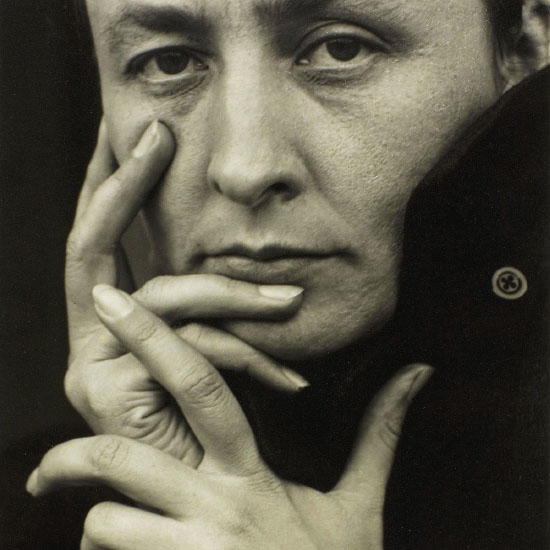
The Investigation
In collaboration with the Georgia O’Keeffe Museum, the Center for Scientific Studies in the Arts is investigating soap formation on oil paintings produced by Georgia O’Keeffe. This research will link the microscale formation of metal carboxylates soap protrusions on paintings by the artist Georgia O’Keeffe to long-term macroscopic changes to these works of art.
The Goal
This research will link the microscale formation of soap protrusions on paintings by O’Keeffe to long-term macroscopic changes to these works of arts. To this end, an open-source and web-based image-analysis tools will be developed to aid conservators in the long-term monitoring of soap protrusions and other alteration phenomena.
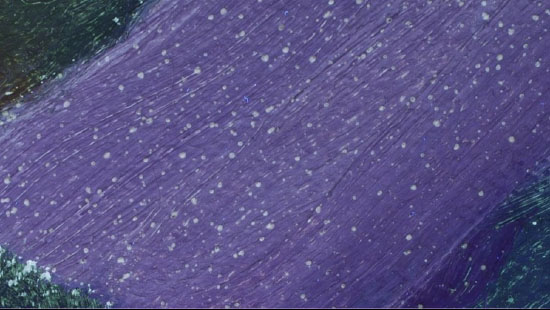
The Process
High-resolution analytical tools will be used to characterize metal soaps in O’Keeffe’s oil paintings. Access the artist’s materials collection at the Georgia O’Keeffe Museum will allow to correlate the material formulations on the occurrence and distribution of protrusions on the artist’s paintings.
Using samples of the soaps, their chemistry will be characterized to better understand the factors contributing to their development. At the same time, non-invasive imaging techniques will be used to detect, map and monitor the micro-eruptions and their evolution over time.
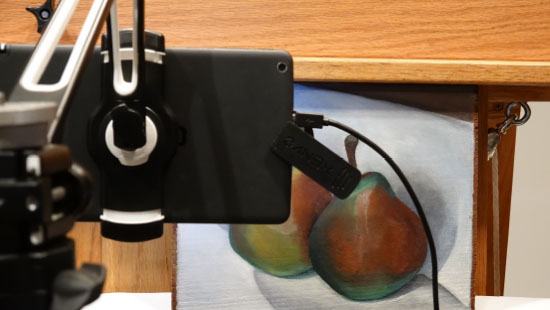
The Impact
We expect this study to provide us with a better understanding of soap formations in Georgia O’Keeffe paintings and to make informed decisions regarding their conservation. In addition, this research will have far-reaching implications on the conservation practices of paintings. To this end, we will develop an open-source software and image-analysis tools to aid conservators in the long-term monitoring of soap protrusions, extending the benefits of the research beyond the O’Keeffe collection to many others similarly affected paintings around the world.
Scientific Tools
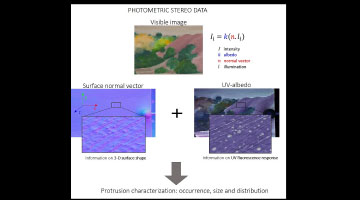
Photometric stereo by UV-induced fluorescence
The use of fluorescence emission as light source for PS of painted surface enable more accurate, precise, and repeatable shape measurements. The use of UV-induced fluorescence presents two benefits: 1) the calculated albedo aids in the accurate detection and segmentation of the protrusions and 2) information on the UV-induced fluorescence response of the protrusions is simultaneously collected in the visible range, which can contribute to materials differentiation and characterization.
For this purpose a set of pictures are taken of the painting with a fixed camera, each shot under a different angle of UV light illumination. Using both the albedo and shape information, two data analysis methods were tested and compared to investigate the occurrence and distribution of protrusions in different colored areas. This method provides quantitative information on the protrusions by detecting all visible protrusions within the investigated region.
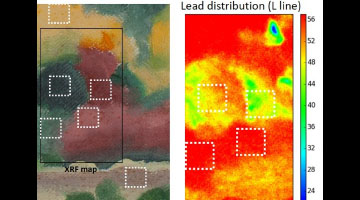
X-ray Fluorescence Imaging
The XRF map allow to obtain elemental distribution images, this non-invasive analytical technique provides a more clear understanding of the painting layers composition. The images obtained reveal the spatial distribution of pigments on or beneath the paint surface.
The XRF performed on Pedernal as a case of study, exhibit a lead elemental distribution map that indicates that lead white was likely mixed with the colored pigments in varying proportions to produce lighter tonalities. The regions that are richest in lead correlate with the areas with a higher occurrence of protrusions. These observations suggest that the specific type of lead white paint formulation in tubes employed by O’Keeffe and its proportion play a critical role in the development of protrusions.
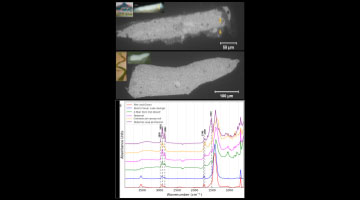
Correlating protrusions with material composition
Microscopical characterization of the samples by means of SEM-EDX allows the identification of two different types of canvases: i) a commercially pre-primed canvas and ii) artist primed canvas. The ground of the commercially primed canvas roll has a similar morphology and composition than the grounds of the canvases used by O’Keeffe in the paintings that contain protrusions.
Organic analysis by Gas Chromatography- Mass Spectrometry (GC-MS) and Fourier Transform Infrared Spectroscopy (FTIR) indicates that the commercially primed canvases were found to contain an excess of free fatty acids and metal carboxylates (lead soaps). The results obtained by means of GC-MS show the presence of a slow-drying oil in the commercial canvas grounds samples, likely from the Brassicaceae family. The combined GC-MS and FTIR results indicate that the protrusions contain primarily lead carboxylates. Based on the analytical results, we concluded that the artist’s use of this particular commercially primed canvas is responsible for the observed micro-protrusions.






